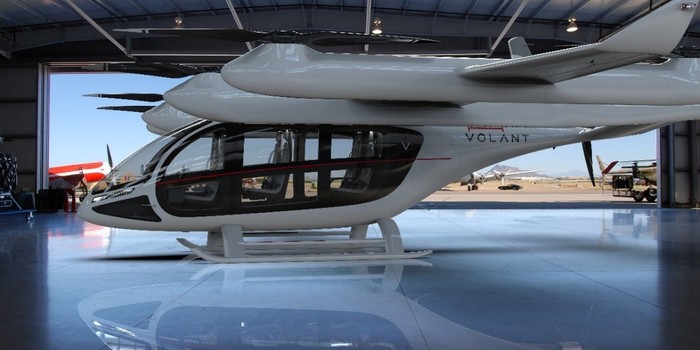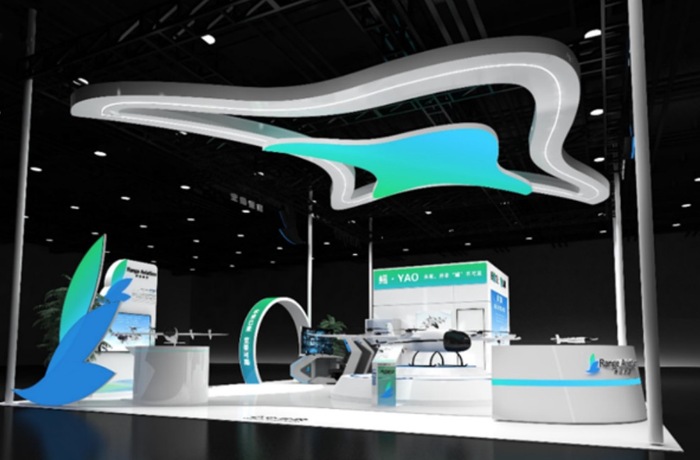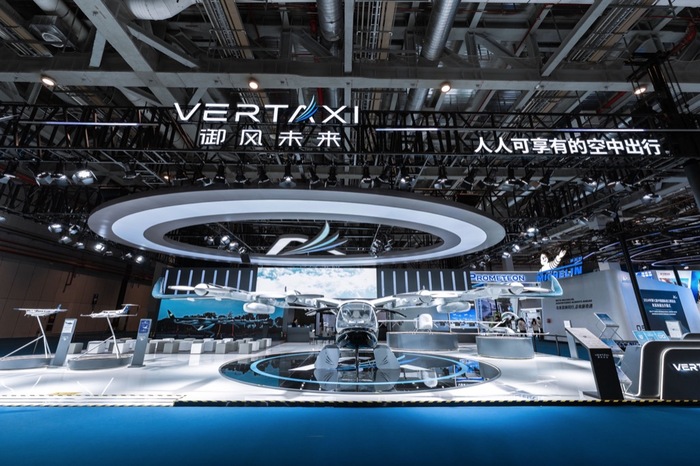
by LIU Sunan
Vertaxi’s first public display of a 2-ton eVTOL ‘flying car’ is turning heads at this year’s China International Import Expo (CIIE). Capable of covering 250 kilometers on a single charge, this vehicle hints at a future where 15-minute air commutes redefine urban travel.
This year marks the "first year of the low-altitude economy," and the CIIE introduced a "future travel" zone for the first time.
Eight months after the "low-altitude economy" was incorporated into the State Council's government work report, four pioneering companies in the sector—Volant Aerotech, Vertaxi, Range Aviation, and TCab Tech—made their debut as a group at the 7th CIIE.
As a leader in commercial passenger eVTOLs, Volant Aerotech showcased its VE25-100 model at CIIE. This fully electric, autonomous air vehicle has a 2.5-ton take-off weight, seats one pilot and five passengers, and features a composite wing structure. With a cruising speed of 235 km/h and a range of 200-400 km, it is the largest manned eVTOL aircraft of its kind, offering the highest take-off weight and most spacious cabin.

In August 2022, Volant launched the VE25 full-scale technical verification aircraft, followed by test flights in January 2023. In September, Volant became East China’s first company to secure airworthiness approval for manned eVTOLs. The airworthiness certification for the VE25-100 began in October 2024, and the aircraft can fly 20 kilometers in 5 minutes at an estimated 60 yuan per seat.
Range Aviation, the youngest low-altitude economy exhibitor, was founded in May 2023. The company presented two models: the LE200, a passenger eVTOL with a 320 km range and capacity for 2-5 passengers, and the LEU100, a logistics drone with a take-off weight of 140 kg, a range of 200 km, and a payload of 55 kg.

The LEU100 has begun the certification process, targeting approval in 2025 and market delivery in 2026.
Vertaxi, the sole eVTOL exhibitor last year, unveiled its 2-ton M1 eVTOL, the expo's largest exhibit with a 15-meter wingspan. Fully electric and autonomous, it has a range of 250 km and a top speed of 200 km/h, potentially enabling 15-minute trips across Shanghai.

The first M1 series was launched in March 2023, with a test flight in October. The CAAC East China Regional Administration began reviewing the M1B (cargo) certification application in January. Vertaxi also showcased its E40H medium UAV and smaller E5, both used extensively.
The company aims for cargo certification by 2025 and manned certification by 2027, with large-scale commercial operations by 2027-2028.
Volant Aerotech announced plans at the expo to sign contracts totaling 3 billion yuan, including the sale of 150 aerial vehicles to four state-owned enterprises. Agreements were also reached with banks, leasing firms, infrastructure developers, and pilot training institutions.
“Through the CIIE platform, we hope the low-altitude economy will start to feel like part of everyday life,” says Huang Xiaofei, partner and senior VP of Volant Aerotech.
He expects more government orders but advises a cautious, gradual rollout for safety, with initial focus on simpler cargo operations before expanding to passenger services.
Last year, Vertaxi’s CIIE debut raised its profile, drawing interest from governments and investors, says CEO Xie Ling. He confirmed to Jiemian News that orders have tripled since then, driven by growing demand and large government procurement orders, such as from Shandong Expressway.
Xie stresses that infrastructure, low-altitude airspace regulation, and standards are essential for scaling operations.
In early 2024, China identified the low-altitude economy as a "new growth engine" in its government report, followed by a March initiative to expedite airworthiness certification for emerging aviation tech like eVTOLs. On November 5, the Ministry of Industry and Information Technology (MIIT) convened to outline strategies for advancing the sector, focusing on enterprise support, talent, finance, and policy.
At the municipal level, significant efforts are underway to accelerate the development of the low-altitude economy, with ambitious infrastructure projects and strategic plans.
On November 5, Shenzhen launched an initiative to accelerate the building of the world’s first comprehensive low-altitude economic infrastructure. The city hopes that by 2026, low-altitude take-off and landing facilities will increase from 249 to 1,200, and over 8,000 new 5G-A base stations will support low-altitude communication.
Additionally, Shenzhen is developing the Smart Integrated Low-Altitude System (SILAS), with the 1.0 version expected in late November to enable safe, large-scale low-altitude operations.
Anhui Province has similar plans, aiming to build around 10 general airports and 150 temporary landing sites by 2025, expanding to 20 airports and 500 sites by 2027, according to its low-altitude economic development plan.
Huang Xiaofei notes to Jiemian News that the industry is maturing, with diversified business models and substantial investor interest. Leading companies are forming alliances, driving the industry beyond sentiment and into rational commercialization.
He projects that initially over half of orders will likely come from government procurement to support industry growth. Later, as the market expands, government focus will shift to public services like emergency response and police aviation, while while state-owned enterprises are expected to contribute through equity investments, remote travel services, and support for international trade.
Jia Xiaodong, Range Aviation’s VP, when speaking with Jiemian News, highlights aviation supply chains and new energy as key beneficiaries, citing partnerships like CATL’s battery collaboration with Fengfei Aviation. Low-altitude infrastructure, traffic management, and safety systems are also primed to benefit, with logistics progressing faster than passenger operations.
“We’re not yet competing in technology but in implementation,” said Jia Xiaodong. “In three to five years, we aim to match and surpass global leaders, becoming the largest low-altitude market.”